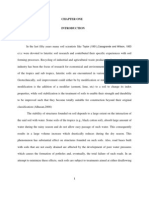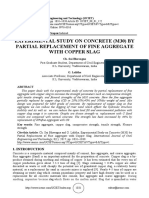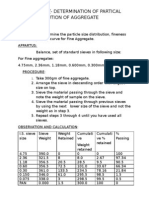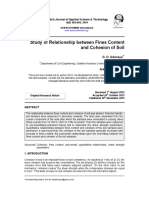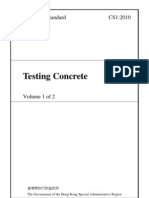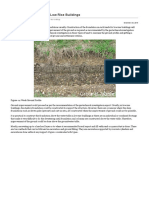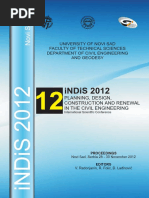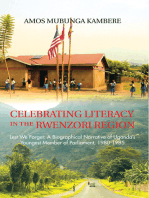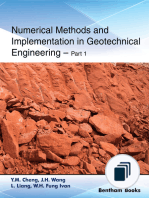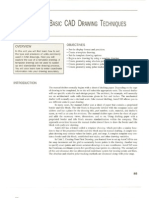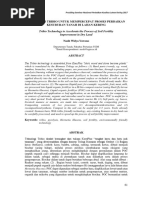Soils and Engineering
Uploaded by
untoniSoils and Engineering
Uploaded by
untoniJournal of Civil Engineering, JKUAT, Vol. 7, March 2002, pp.
1-8
Engineering properties of common subgrade soils below pavement structures in Kenya
Sixtus K. Mwea 1) and Francis J. Gicbaga 2)
1) Senior Lecturer, Department of Civil Engineering, University of Nairobi
2) Professor of Civil Engineering, Department of Civil Engineering University of Nairobi, and Chairman, Kenya National Council of Science and Technology
ABSTRACT
This paper reports findings of laboratory testing of common subgrade soils in pavement structures in Kenya. The materials were collected from different parts of the country. The results are intended to form a database for use by practicing engineers and researchers in the field of pavement engineering. The investigated materials include the expansive black soils, silty clayey soils, sandy loamy clayey soils and lateritic gravels. In addition the properties of lime improved gravels are reported. For the fine-grained soils the plasticity index was found to be linearly proportional to the liquid limit. In all the investigated soils the optimum moisture content was found to be inversely proportional to the maximum dry density. The increase in the strength of lime improved materials was found to increase with lime content at a diminishing effect.
Key words ~ pavements, expansive black soils, silty clayey soils, sandy loamy clayey soils and lateritic gravels
INTRODUCTION
Flexible pavement design revolves around obtaining a pavement cover over a subgrade soil. The cover thickness for a particular pavement material is dependent on the subgrade strength and its plasticity. Subgrade materials in Kenya comprise of natural soils found in different geological state and conditions varying across the breadth and width of the country (Roads Department, 1987). Some of the previous studies aimed at studying the pavement material properties include Gichaga et al (1987) who investigated the properties of Nairobi red coffees soils and Mwea and Ngware (1996) who investigated the properties of Uashin Gichu red coffee soils. Gichaga (1982) studied the deformation modulus - time relationships for various subgrade soils under road pavements. Under the study the basic engineering properties of the investigated soils were established. The significant properties are summarized on Table 1
T bilE .
f b d 'I
a e ngineenng properties 0 su igra e SOl s
Murram from Red soil from Black cotton soil
Thika road Langata from Langata
Liquid Limit (%) 34 53 83
Plasticity Index (%) 10 17 32
Maximum Dry Density (kg/m '] 1630 1480 1330
Optimum Moisture content (%) 23 29 31 Source: Gichaga (1982)
1
FIELD SAMPLING
Pavement subgrade soils were collected from various parts of the country (Figure 1). Expansive black clays commonly known as black cotton soils were sampled from Bunyala division of Western province. In this area, roads were being designed to serve a large irrigation project covering a large area. The area sampled is on the River Nzoia flood plains. The soils here are predominantly black cotton soils. To fully identify and characterize the soils for the roads in the irrigated areas a sampling grid of one kilometer was adopted.
The red silty clays commonly known as red coffee soils were sampled at two locations in Meru district in Eastern Province. The locations of sampling were Liutu and Likiundu. The samples were taken on the proposed alignment of access roads to an earth-dam that was under design. The area here is generally hilly and well drained. The depth of the red soils cover was found to be over ten meters, but sampling was done in the top one and half meters. This is the depth where engineering activities with respect to the access roads were confined.
Subgrade soils were also sampled along the Wote - Makindu road. This earth/gravel road passes through a semi-arid part of Makueni district in Eastern Province. The sixty fivekilometer road passes through predominantly sandy loamy silt clays. Sampling was carried out at one-kilometer intervals to depth of one and half meter depth. The road was being designed with an aim of improving it to a bitumen-surfaced road.
Lateritic gravels were also obtained from Western province divisions of Mumias and Amagoro. These were to be used in the construction of the irrigation scheme roads. Several gravel quarries along the Wote-Makindu road were also investigated. The quarries were to be the source of base and subbase materials for the improved road .
./
Figure 1 Location sites for pavement building materials
2
LABORATORY TESTING
Samples from the field were subjected to identification, compaction and strength tests. Lateritic gravels are usually used in the subbase and the base layers of the pavement structures. For these soils therefore further testing was required to assess their suitability in the upper pavement layers. The lateritic gravel samples obtained from Wote-Makindu road were therefore tested after lime improvement in addition to the above tests.
CLASSIFICATION OF FINE-GRAINED SOILS (BLACK COTTON SOILS AND RED COFFEE SOILS).
The results of the plasticity test are plotted on the plasticity chart for the unified classification system (Smith and Smith, 1998) on Figure 2a and 2b.
50
.....
! 40
~
"
.s
30
~ 20 ~ 10
"
a: 0
o 10 20 30 40 50 60 70 Liquid Limit (%)
a) Black cotton soils (WestemKenya)
(b) Red coffee soils (Meru)
50
!4O j 30
~ 20 .!!
1 10
L
o
o 10 20 30 40 50 60 70
Liquid limit (%)
Figure 2 Classification of the fine grained soils
For the black cotton soils from Western Kenya it was found that the soils band around the A line. The majority of the sam,ples were found to lie above the 50% liquid limit (LL). These soils are therefore, clays or silts of high compressibility (CH and MH) Equation 1 shows the correlation of plasticity index (PI) and LL for the investigated soils. The red coffee soils from Meru district were found to plot below the A Iine also above the 50% LL. These soils are therefore silts of high compressibility. Equation 2 shows the correlation of PI and LL for the red coffee soils.
PI = -0.5 + 0.45LL (r= 0.64) PI= -15.62 + 0.64LL (r=0.84)
{1/ {2/
Comparison with Nairobi red coffee soils, which were, investigated by Gichaga et al (1987) and Kipwen red coffee soils (Mwea and Ngware 1996) in Uashin Gichu district of the Rift valley shows that these soils are similar as can be seen on Figures 3a and 3b.
3
-------~-----------------,
40 ~ 35 -; 30
-8 25
c
- 20 b
U 15
i 10
I'J
Ii:
40
--
rft
-; 30
i
._ 20
b
u
i 10 Ii:
o
o 10 20 30 40 50 60 70 Liquid Limit (%)
o 10 20 30 40 50 60 70 80 Liquid limit (%)
(b) Uashln Gichu
SOUTCB: MwtUI and Ng_,. (1996)
(a) Nairobi SOUTCfll Glchaga fit al (1987)
~----------------------~ L ~
Figure 3 Classification of Nairobi and Uashin Gichu red coffee soils
CLASSIFICATION OF THE SANDY LOAMY SOILS ALONG THE WOTEMAKINDU ROAD
The variation of the geotechnical properties of the sub grade soils along the sixty fivekilometer road corridor was found to be large. The fine portions of soils were found to be of low plasticity with an average PI of 14%. Overall, the sand proportion was found to be high (58%) with high proportion of fines plotting above the A line and below the 50% liquid limit mark (Figure 4). The soils can therefore be classified as clayey SANDS (SC).
o
10
20
10
30
4q
50
60
Liquid Limit (%)
Figure 4 Classification of sandy loamy soils on the Wote - Makindu road
CLASSIFICATION OF THE LATERITIC GRAVEL SOILS
Unified soils classification (USC) of soils with fine portions less than fifty percent depends on the particle size distribution, and the plasticity of the fines. Using the mean values for the test results, the classification for the various investigated gravel soils is shown in Table 2
4
T bi 2 CI 'fi
fl t .,
a e ass! ication 0 a enuc grave s. ' _(
Location LL(%) PI (%) Gravel (%) Sand (%) Fines (o/<0_ USC
Mumias 42 13 70 17 13 GM
Amagoro 35 11 73 16 11 GM-P
Wote-Makindu 38 15 50 32 18 GC Legend: - LL - Liquid limit, PI -- Plasticity index
Gravel from Western Province (Mumias and Amagoro) was found to have lower percentage of fines than the gravel from quarries located along Wote-Makindu road in Eastern Province. The Mumias gravel can be classified as silty GRAVEL (GM), while that from Amagoro had less than 12% fines but more than 5%. It is therefore described as a poorly graded silty GRAVEL (GM-P). The Wote-Makindu quarries had a higher percentage of sand and fines. These gravels are classified as silty GRAVEL (GM).
COMPACTION CHARACTERISTICS
The optimum moisture content (OMC) is the water content at which the maximum dry density (MDD) has been achieved. In all the tested soils the variation of OMC with MDD was found to be of the form given in Equation 3. Statistical analysis of OMC versus MDD was done. Table 3 shows the statistical constants related to Equation 3. The results for the general equation is shown graphically on Figure 5
OMC=A -MDDIB
Table 3 Statistical constants for MDD Vs OMC (Equation 3)
Soil TVlJe A B r
Black cotton Soils 71 32 -.85
Red coffee soils 84 27 -.92
Lateritic gravel soils 66 38 -.89
Clayey sands 54 47 -.92
General equation 66 37 -.93 Legend - A & B -constants, r - coefficient of correlation
-~--~.-----,------------
50
40
~30
-
(J
::E 20 o
10
o 1200 1400 1600 1800 2000 2200 2400
MDD (kg/m3)
Figure 5 OMC Vs MDD for Kenyan subgrade soils
13J
PROPERTIES OF THE FINE-GRAINED SOILS WITH RESPECT ro PAVEMENT PERFORMANCE
Black cotton soils
The black cotton soils tend to be problematic soils. Their low strength, high plasticity and swell characteristics affect their performance under traffic load. It is for this reason that the Roads Department (1987) recommends that the black cotton soils be placed in the lower sections of the fill where the weight counteracts the expansion of the soil. This treatment of expansive soils compares with the recommendations of the State of California (1992) handling of expansive clays where a surcharge is placed over expansive soils before placement of he pavement structures. Ibi (1992) also recommends the treatment of the expansive soils with lime.
The strength of the black cotton soils was investigated by the measurement of CBR and plasticity. The mean CBR for the test samples was four. This placed them in the S 1 subgrade class (Roads Department, 1987). The use of such weak soils as a sub grade material is to be avoided. They should be either replaced or an improved sub grade is used as cover. The CBR was found to be linearly related with plasticity index (PI). This can be explained by the fact that CBR is a measure of the shearing strength of the soil. On the other hand PI is a measure of the range of water contents when the soil is in the plastic stage. This is a weak stage of the soil and regression analysis of the experimental data gave Equation 4
eBR = 11- 0.33P1 (r= 0.82)
[4J
Red coffee soils
The investigated red coffee soils had their CBR values in the range of 9-49. This places them in the subgrade regions of S3-S5 (Roads Department, 1987). These fine-grained soils are suitable pavement foundation. The pavement design over these soils revolves around the selection of a pavement structure depending on the traffic loading and available pavement materials.
Unlike the black cotton soils these soils were found to have the CBR not well correlated to their PI. The poor correlation is due to their coarser particles and the gradation becoming increasingly important in the strength characteristics. Indeed for the lateritic gravels it was found out that strength was now inversely related to the percentage of fines as discussed in the next section.
Lateritic gravels
The results for the tested gravel soils show considerable variation in plasticity and strength characteristics. The strength of the soils was found to be inversely proportional to the plasticity modulus (PM). The plasticity modulus is defined as a product of PI and % passing 0.425mm sieve size. The strength was also found to be inversely proportional to the percentage of fines. Figure 6 shows the trend of CBR with PM and percentage of fines. The relationship shows a high scatter and is indicative of the difficulty in linking of the strength and the plasticity modulus.
Table 4 shows the Roads Department (1987) requirements for gravel when used as base or subbase material. From Figure 6 it can be seen that a large percentage of gravel in the area of investigation does not meet the plasticity and strength characteristics. Indeed for the twenty quarries investigated along the Wote-Makindu road none met the design requirements for the base while only 60 % were suitable for the subbase.
6
T bl 4 G
I h
t . t'
. d f
bb
db
a e rave c arac ens lCS require or su ase an ase
Layer Minimum CBR (%) Maximum PI Maximum PM:
Base 80 15 250
Subbase 30 15 250 Legend: PI - Plasticity index, PM - Plasticity modulus Source: Roads Department, 1987
Lime improvement was performed on the samples from Wote-Makindu road. In all the cases the effect of addition of lime was to reduce the plasticity and plasticity modulus. This was accompanied by an increase in the strength of the gravel. All the samples had their PI and PM values falling considerably. For the four and six percentage contents, the samples were non-plastic and hence PM reduced to zero. Overall the increase in lime content enhanced the strength as assessed by CBR but with diminishing effect as the percentage of the lime increases. This can be seen in Figure 7 that was developed from the test results. The trend in the figure is polynomial relationship with a coefficient of determination (r2) of 0.69.
Deformation Modulus of the fine grained soils
Gichaga (1982) established that the deformation modulus of the fine-grained sub grade soils decreases with time of loading. Table 5 shows the decrease in loading time from 10-2 seconds the time of loading equivalent to a vehicle at 100 km per hour to a loading time of 12 days (l06 seconds). The overall result is that soils undergo substantial loss in modulus with loading time and that the loss in stiffness varies with the type of soil.
T bl 5 M d I (MNI 2) T
1 ti hi s for Kenyan sub grade soils
a e o u us m - ime re a ions 11)
Loading Time (Sec) lO-L 10L lOb
Lateritic Gravel 637 274 25
Red Coffee Soil 12 5.4 0.98
Black Cotton Soil 16 6.4 0.39 Source Gichaga (1982)
l100
ri
o
20
30
40
50
% Fine.
Wote Maklndu road lateritic gravel.
o
10
20
30
40
PM
(b) Wote Maklndu road lateritic
gravel.
Figure 6 Variation of CDR with plasticity modulus and % fines
7
300
250
- 200
~
-- 150
&II:
III
U 100
50
0
0 Lime Content (LC) 0/0
---~-----
Figure 7 Effect of lime on CDR for lateritic gravels
CONCLUSIONS
The properties of pavement materials have been presented. Relationships of optimum moisture content and maximum dry density have been are presented. Some of the factors affecting pavement strength have been identified as plasticity and percentage of fines. The increase in strength as measured by CBR of lime improved materials have been quantified. The specific conclusions, which can be drawn from the study, are:
1 The plasticity index of the soils increases with the liquid limit
2 The optimum moisture content of the soils decreases with maximum dry density
3 The strength of the soils decreases with the plasticity index
4 The increase in strength of lime improved gravels increases with lime content with diminishing effect.
RECOMMENDATIONS
It is recommended that the various subgrade soils in the country be tested under repeated loading to mode'! out the actual field conditions
REFERENCES
Gichaga FJ (1982). Laboratory study of deformation modulus - time relationships for various subgrade soils under road pavement structures. Kenya Journal of Science and Technology series A Vol 3, No 2 pp 63-73
Gichaga FJ Sahu BK and Visweswaraiya TG (1987) Compaction and compression characteristics of Red coffee soils in Kenya In proceedings of the eighth international conference for soil mechanism and foundations engineering. Cartagena, Colombia pp 295-304.
Mwea SK and Ngware R (1996). Suitability of the Kipwen River basis soils with respect to earth-dam construction. Discovery and innovation Volume & Number 2 pp .119-131 Roads Department (1987). Road design manual part Ill. Materials and pavement design for new roads. Ministry of public Works Nairobi.
Smith GN and Smith IGN (1998) Elements of soil mechanics seventh edition pp494 Blackwell science Ltd. UK.
State of California, Department of Transportation (1992). Highway design manual, chapter 600. Design of the pavement section pp. 1-74
8
You might also like
- 01 - Preliminary Design Presentation July 18 2013No ratings yet01 - Preliminary Design Presentation July 18 201396 pages
- James J Smolen Cased Hole and Production LogNo ratings yetJames J Smolen Cased Hole and Production Log6 pages
- Pt. Diachems Resins Indonesia 5Th Train Expansion Project Production Building Calculation ReportNo ratings yetPt. Diachems Resins Indonesia 5Th Train Expansion Project Production Building Calculation Report42 pages
- Experimental Study On Concrete (M30) by Partial Replacement of Fine Aggregate With Copper SlagNo ratings yetExperimental Study On Concrete (M30) by Partial Replacement of Fine Aggregate With Copper Slag8 pages
- How To Model A Square Foundation On PlaxisNo ratings yetHow To Model A Square Foundation On Plaxis4 pages
- Onyancha - Geological and Geotechnical Conditions of NairobiNo ratings yetOnyancha - Geological and Geotechnical Conditions of Nairobi234 pages
- Suitable of Eggshell Stabilized Lateric SoilNo ratings yetSuitable of Eggshell Stabilized Lateric Soil10 pages
- Compiled Infrastructure Assignment KadduNo ratings yetCompiled Infrastructure Assignment Kaddu25 pages
- Determination of Partical Size Distribution of AggregateNo ratings yetDetermination of Partical Size Distribution of Aggregate5 pages
- Bearing Capacity of Shallow FoundationsNo ratings yetBearing Capacity of Shallow Foundations16 pages
- 2 Geotechnical Engineering CE S4 B.Tech KTU 2017 PDFNo ratings yet2 Geotechnical Engineering CE S4 B.Tech KTU 2017 PDF2 pages
- A Study On Stabilization of Black Cotton Soil Using Rice Husk AshNo ratings yetA Study On Stabilization of Black Cotton Soil Using Rice Husk Ash10 pages
- Soil Mechanics: Unconsolidated Consolidation100% (4)Soil Mechanics: Unconsolidated Consolidation25 pages
- Study of Relationship Between Fines Content and Cohesion of SoilNo ratings yetStudy of Relationship Between Fines Content and Cohesion of Soil11 pages
- Geotechnical Investigation (Plot.503, SQ 4) (Optimized)No ratings yetGeotechnical Investigation (Plot.503, SQ 4) (Optimized)26 pages
- Behavior of Unsaturated Soils For Road Pavement Structure Under Cyclic LoadingNo ratings yetBehavior of Unsaturated Soils For Road Pavement Structure Under Cyclic Loading272 pages
- Faculty of Engineering - CEES - University of RuhunaNo ratings yetFaculty of Engineering - CEES - University of Ruhuna51 pages
- Finite Element Method in Geotechnical EngineeringNo ratings yetFinite Element Method in Geotechnical Engineering18 pages
- Structural Design Assignment 1 - Beam DesignNo ratings yetStructural Design Assignment 1 - Beam Design8 pages
- A Study of Black Cotton Soil Stabilization With Lime and Waste Plastic Bottle StirrupNo ratings yetA Study of Black Cotton Soil Stabilization With Lime and Waste Plastic Bottle Stirrup8 pages
- RCK - Effect of Weathering On The Strength and Modulus of Basalt and Siltstone (Gu Et Al, 2008)No ratings yetRCK - Effect of Weathering On The Strength and Modulus of Basalt and Siltstone (Gu Et Al, 2008)8 pages
- Ground Improvement For Low Rise Buildings - Structural GuideNo ratings yetGround Improvement For Low Rise Buildings - Structural Guide3 pages
- Shin Thant Aung Highway Engineering Assignment-1 HND: 1854C100% (1)Shin Thant Aung Highway Engineering Assignment-1 HND: 1854C14 pages
- Ce 442 Foundation Engineering II - Tedu s1617 - SyllabusNo ratings yetCe 442 Foundation Engineering II - Tedu s1617 - Syllabus8 pages
- Presentable Industrial Training Experience GabrielNo ratings yetPresentable Industrial Training Experience Gabriel15 pages
- Lecture 1 - Slope Safety System Part 1-1No ratings yetLecture 1 - Slope Safety System Part 1-114 pages
- Applications of Geosynthetics To Canals: Case Study - 1 Restoration of Main Canal of Sardar Sarovar ProjectNo ratings yetApplications of Geosynthetics To Canals: Case Study - 1 Restoration of Main Canal of Sardar Sarovar Project21 pages
- Parametric Study of Different Types of Diaphragm Wall Using Soil - Structure Interaction For Section OptimizationNo ratings yetParametric Study of Different Types of Diaphragm Wall Using Soil - Structure Interaction For Section Optimization7 pages
- Assignment I Field Exploration & Soil Testing100% (1)Assignment I Field Exploration & Soil Testing12 pages
- Raft Foundation - Design Requirements and ApplicabilityNo ratings yetRaft Foundation - Design Requirements and Applicability4 pages
- Numerical Methods and Implementation in Geotechnical Engineering – Part 1From EverandNumerical Methods and Implementation in Geotechnical Engineering – Part 1No ratings yet
- Celebrating Literacy in the Rwenzori Region: Lest We Forget: a Biographical Narrative of Uganda’S Youngest Member of Parliament, 1980-1985From EverandCelebrating Literacy in the Rwenzori Region: Lest We Forget: a Biographical Narrative of Uganda’S Youngest Member of Parliament, 1980-1985No ratings yet
- A Catalogue of Details on Pre-Contract Schedules: Surgical Eye Centre of Excellence - KathFrom EverandA Catalogue of Details on Pre-Contract Schedules: Surgical Eye Centre of Excellence - KathNo ratings yet
- Effect of Gradation and Plasticity On Compaction Characteristics PDFNo ratings yetEffect of Gradation and Plasticity On Compaction Characteristics PDF3 pages
- Geotechnical Properties of Soils From Wukari Taraba StateNo ratings yetGeotechnical Properties of Soils From Wukari Taraba State9 pages
- Pavement Engineering in Developing Countries100% (1)Pavement Engineering in Developing Countries35 pages
- Public Transport Presentation - Nairobi MetropolitanNo ratings yetPublic Transport Presentation - Nairobi Metropolitan49 pages
- 106 - Literature Review Stabilised Sub-BasesNo ratings yet106 - Literature Review Stabilised Sub-Bases38 pages
- Chapter 2 - Thematic Area 1 - Geometric Design100% (2)Chapter 2 - Thematic Area 1 - Geometric Design35 pages
- Railway Earthwork, Blanket and Ballast Limit and Real ResultsNo ratings yetRailway Earthwork, Blanket and Ballast Limit and Real Results14 pages
- Ametrine Value, Price, and Jewelry Information - International Gem SocietyNo ratings yetAmetrine Value, Price, and Jewelry Information - International Gem Society5 pages
- Eduardo P. Paningbatan, Jr. PHD Professor of Soil PhysicsNo ratings yetEduardo P. Paningbatan, Jr. PHD Professor of Soil Physics90 pages
- 2.lecture - Mekanika Batuan - TGL - Karakterisasi Intact Rock-WK2-2018No ratings yet2.lecture - Mekanika Batuan - TGL - Karakterisasi Intact Rock-WK2-20189 pages
- Determination of Radial Coefficient of Consolidation Using Log I T I MethodNo ratings yetDetermination of Radial Coefficient of Consolidation Using Log I T I Method10 pages
- Algodonite Value, Price, and Jewelry Information - Gem SocietyNo ratings yetAlgodonite Value, Price, and Jewelry Information - Gem Society6 pages
- TENGCO - Laboratory Activity 1 - Standard Practice For Description and Identification of Soils (Visual-Manual Procedures) D2488No ratings yetTENGCO - Laboratory Activity 1 - Standard Practice For Description and Identification of Soils (Visual-Manual Procedures) D24884 pages
- Teknologi Tribio Untuk Mempercepat Proses Perbaikan - 2No ratings yetTeknologi Tribio Untuk Mempercepat Proses Perbaikan - 214 pages
- SCS TR-55 Peak Discharge and Runoff CalculatorNo ratings yetSCS TR-55 Peak Discharge and Runoff Calculator5 pages
- 32 Source, Time and Method of Fertilizer ApplicationNo ratings yet32 Source, Time and Method of Fertilizer Application13 pages
- Cogon Fiber in Earth Brick As A Sustainable Building MaterialNo ratings yetCogon Fiber in Earth Brick As A Sustainable Building Material7 pages
- Laporan Kemajuan Pekerjaan (LKP) : Apln Lot 1 Gi Rantauprapat ExtNo ratings yetLaporan Kemajuan Pekerjaan (LKP) : Apln Lot 1 Gi Rantauprapat Ext2 pages
- Pt. Diachems Resins Indonesia 5Th Train Expansion Project Production Building Calculation ReportPt. Diachems Resins Indonesia 5Th Train Expansion Project Production Building Calculation Report
- Experimental Study On Concrete (M30) by Partial Replacement of Fine Aggregate With Copper SlagExperimental Study On Concrete (M30) by Partial Replacement of Fine Aggregate With Copper Slag
- Onyancha - Geological and Geotechnical Conditions of NairobiOnyancha - Geological and Geotechnical Conditions of Nairobi
- Determination of Partical Size Distribution of AggregateDetermination of Partical Size Distribution of Aggregate
- 2 Geotechnical Engineering CE S4 B.Tech KTU 2017 PDF2 Geotechnical Engineering CE S4 B.Tech KTU 2017 PDF
- A Study On Stabilization of Black Cotton Soil Using Rice Husk AshA Study On Stabilization of Black Cotton Soil Using Rice Husk Ash
- Study of Relationship Between Fines Content and Cohesion of SoilStudy of Relationship Between Fines Content and Cohesion of Soil
- Geotechnical Investigation (Plot.503, SQ 4) (Optimized)Geotechnical Investigation (Plot.503, SQ 4) (Optimized)
- Behavior of Unsaturated Soils For Road Pavement Structure Under Cyclic LoadingBehavior of Unsaturated Soils For Road Pavement Structure Under Cyclic Loading
- Faculty of Engineering - CEES - University of RuhunaFaculty of Engineering - CEES - University of Ruhuna
- A Study of Black Cotton Soil Stabilization With Lime and Waste Plastic Bottle StirrupA Study of Black Cotton Soil Stabilization With Lime and Waste Plastic Bottle Stirrup
- RCK - Effect of Weathering On The Strength and Modulus of Basalt and Siltstone (Gu Et Al, 2008)RCK - Effect of Weathering On The Strength and Modulus of Basalt and Siltstone (Gu Et Al, 2008)
- Ground Improvement For Low Rise Buildings - Structural GuideGround Improvement For Low Rise Buildings - Structural Guide
- Shin Thant Aung Highway Engineering Assignment-1 HND: 1854CShin Thant Aung Highway Engineering Assignment-1 HND: 1854C
- Ce 442 Foundation Engineering II - Tedu s1617 - SyllabusCe 442 Foundation Engineering II - Tedu s1617 - Syllabus
- Presentable Industrial Training Experience GabrielPresentable Industrial Training Experience Gabriel
- Applications of Geosynthetics To Canals: Case Study - 1 Restoration of Main Canal of Sardar Sarovar ProjectApplications of Geosynthetics To Canals: Case Study - 1 Restoration of Main Canal of Sardar Sarovar Project
- Parametric Study of Different Types of Diaphragm Wall Using Soil - Structure Interaction For Section OptimizationParametric Study of Different Types of Diaphragm Wall Using Soil - Structure Interaction For Section Optimization
- Raft Foundation - Design Requirements and ApplicabilityRaft Foundation - Design Requirements and Applicability
- Numerical Methods and Implementation in Geotechnical Engineering – Part 1From EverandNumerical Methods and Implementation in Geotechnical Engineering – Part 1
- Celebrating Literacy in the Rwenzori Region: Lest We Forget: a Biographical Narrative of Uganda’S Youngest Member of Parliament, 1980-1985From EverandCelebrating Literacy in the Rwenzori Region: Lest We Forget: a Biographical Narrative of Uganda’S Youngest Member of Parliament, 1980-1985
- A Catalogue of Details on Pre-Contract Schedules: Surgical Eye Centre of Excellence - KathFrom EverandA Catalogue of Details on Pre-Contract Schedules: Surgical Eye Centre of Excellence - Kath
- Effect of Gradation and Plasticity On Compaction Characteristics PDFEffect of Gradation and Plasticity On Compaction Characteristics PDF
- Geotechnical Properties of Soils From Wukari Taraba StateGeotechnical Properties of Soils From Wukari Taraba State
- Public Transport Presentation - Nairobi MetropolitanPublic Transport Presentation - Nairobi Metropolitan
- Railway Earthwork, Blanket and Ballast Limit and Real ResultsRailway Earthwork, Blanket and Ballast Limit and Real Results
- Ametrine Value, Price, and Jewelry Information - International Gem SocietyAmetrine Value, Price, and Jewelry Information - International Gem Society
- Eduardo P. Paningbatan, Jr. PHD Professor of Soil PhysicsEduardo P. Paningbatan, Jr. PHD Professor of Soil Physics
- 2.lecture - Mekanika Batuan - TGL - Karakterisasi Intact Rock-WK2-20182.lecture - Mekanika Batuan - TGL - Karakterisasi Intact Rock-WK2-2018
- Determination of Radial Coefficient of Consolidation Using Log I T I MethodDetermination of Radial Coefficient of Consolidation Using Log I T I Method
- Algodonite Value, Price, and Jewelry Information - Gem SocietyAlgodonite Value, Price, and Jewelry Information - Gem Society
- TENGCO - Laboratory Activity 1 - Standard Practice For Description and Identification of Soils (Visual-Manual Procedures) D2488TENGCO - Laboratory Activity 1 - Standard Practice For Description and Identification of Soils (Visual-Manual Procedures) D2488
- Teknologi Tribio Untuk Mempercepat Proses Perbaikan - 2Teknologi Tribio Untuk Mempercepat Proses Perbaikan - 2
- 32 Source, Time and Method of Fertilizer Application32 Source, Time and Method of Fertilizer Application
- Cogon Fiber in Earth Brick As A Sustainable Building MaterialCogon Fiber in Earth Brick As A Sustainable Building Material
- Laporan Kemajuan Pekerjaan (LKP) : Apln Lot 1 Gi Rantauprapat ExtLaporan Kemajuan Pekerjaan (LKP) : Apln Lot 1 Gi Rantauprapat Ext










